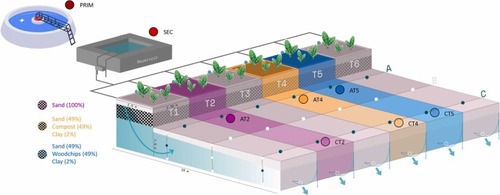Fig. 1
- ID
- ZDB-FIG-240410-17
- Publication
- Sanz et al., 2023 - Efficient removal of toxicity associated to wastewater treatment plant effluents by enhanced Soil Aquifer Treatment
- Other Figures
- All Figure Page
- Back to All Figure Page
|
Simplified scheme of the pilot SAT system. The three SAT systems with different barrier compositions studied in the present work are represented. Color pink codes for the SAT without reactive barrier filled only with sand, color orange codes for the SAT with a reactive barrier made of sand (49%), compost (49), and clay (2%), and color blue codes for the SAT with a reactive barrier made of sand (49%), woodchips (49), and clay (2%). Samples were taken prior WWTP treatment (PRIM), after WWTP at the effluent reservoir (SEC), after the immediate passage through the reactive barrier (A), and at the very end of the systems (C). Water samples were collected in two different campaigns, June and October 2020 (further referred as JUN20, and OCT20, respectively), through a recharge period with a continuous allocated inflow and a recharge period with a pulsating allocated inflow, respectively. |
Reprinted from Journal of hazardous materials, 465, Sanz, C., Sunyer-Caldú, A., Casado, M., Mansilla, S., Martinez-Landa, L., Valhondo, C., Gil-Solsona, R., Gago-Ferrero, P., Portugal, J., Diaz-Cruz, M.S., Carrera, J., Piña, B., Navarro-Martín, L., Efficient removal of toxicity associated to wastewater treatment plant effluents by enhanced Soil Aquifer Treatment, 133377133377, Copyright (2023) with permission from Elsevier. Full text @ J. Hazard. Mater.

